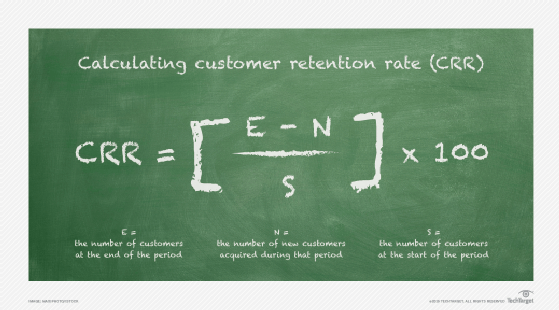customer retention
What is customer retention?
Customer retention is a metric that measures customer loyalty, or an organization's ability to retain customers over time. It identifies the number of loyal customers and can reflect or predict customer satisfaction, repurchase behavior, customer engagement and emotional ties to a brand.
Customer relationships typically begin with an initial interaction, and include all subsequent purchases, transactions and other interactions. When customer retention is measured, organizations can use this feedback to perform data analysis on components of customer experience (CX) and its business success. For example, if a drop in customer retention is reported, an organization can use this to help identify the root cause and adjust its product or service offerings.
Why is customer retention important for businesses?
Customer retention is critical because the acquisition costs of acquiring new customers are much higher than retaining existing customers. Retained customers are also more likely to engage in word-of-mouth marketing or become brand ambassadors.
If an organization doesn't focus on customer retention but instead focuses solely on expanding its customer base, it's potentially losing out on repeat customers. Generating and keeping recurring customers keeps the customer churn rate low and is just as important a process as gaining new ones.
According to this Annexcloud.com blog, nearly 65% of a company's business comes from repeat customers and a 5% increase in customer retention can increase profits by up to 75%. The more loyal an individual becomes to a business, the more likely they are to try new products and bring in other new customers through referrals and testimonials.
Both customer acquisition and customer retention are part of a well-thought-out customer service plan and the key performance indicators (KPIs) included in that plan. Customer service plans provide guidance for meeting or exceeding those KPIs and extending customers' lifetime value to an organization.
How to measure customer retention and key metrics
Customer retention is typically measured in terms of retention rate and should be monitored continuously. The first step in determining this customer retention metric is to identify the time period an organization wants to monitor. This can range from a month to a fiscal year or beyond. Other factors used to determine the retention rate include the following:
- The number of customers in the customer base at the start of the period (S).
- The total number of customers at the end of the period (E).
- The number of new customers acquired over time (N).
Once these metrics are recorded, the formula for the percentage of customers an organization retained over a given period is calculated as follows:
[(E-N) ÷ S] x 100 = retention rate
If an organization starts with 750 customers and ends with 950, but it acquires 625 over the period of time in question, the customer retention rate is 43.3%.

8 customer retention strategies
Some best practices and strategies to facilitate customer retention include these eight:
- Data collection and analysis. Customer data can help organizations learn about customer preferences and offer better, more personalized service and support.
- Personalized service. Providing customers with service tailored to their needs improves CX and fosters loyalty.
- Trust. Building relationships with customers on trust helps increase brand loyalty and repeat purchases.
- Social media. Sites such as Twitter, LinkedIn and Facebook help organizations reach out to customers, build relationships and respond to customer support queries.
- Loyalty incentives. Providing various incentives within a customer retention program can increase customer loyalty. This can be done through customer loyalty programs or by offering discounts or credit.
- Customer feedback. Gathering feedback from customers lets organizations better understand customer expectations and customer behavior.
- Customer support services. Implementing advanced CX tools helps organizations better respond to customer needs and queries quickly. In addition, encouraging customers to create online accounts increases their engagement.
- Customer relationship management tools. CRM tools keep track of customer journeys and monitor whether each customer has become loyal or recurring.
All these strategies help build trust and engagement between an organization and a customer. This, in turn, boosts the chances of current customers becoming repeat ones.

Examples of customer retention
Because customer retention can be achieved through various strategies, one organization's retention approach might look different from another. Here are a few examples:
- Bombas. The sock and apparel retailer donates a clothing item to a homeless shelter or homeless charity with every purchase. This process gives customers a way to help people in need and associate their generosity with Bombas.
- Dollar Shave Club. This company's website uses a bot that answers customer questions. Customers can type a question or select from a preset list of commonly asked ones. This approach lets potential customers quickly get simple concerns answered and make faster purchase decisions.
- Caffé Nero. Like many food service vendors, this London-based business uses loyalty cards and a gamification strategy to incentivize customer retention. Customers get a stamp punched on their cards every time they order coffee or tea; after nine stamps, they get a free beverage.
Benefits of customer retention
Customer retention is one way to measure customer happiness. It also delivers a number of other benefits:
- Improves customer loyalty. The right approach to customer retention can increase customer loyalty, which shows up in repeat business and interest in product extensions.
- Demonstrates customer loyalty. Having a quantitative metric of customer loyalty is valuable. Investors and other stakeholders often use customer retention to gain insight into how a business is doing.
- Increases revenue. Happy customers buy more goods and services.
- Improves marketing strategies. Changes in customer retention numbers can help identify strengths and weaknesses in a business's strategy, leading to potential improvements.
- Provides a customer acquisition alternative. The high cost of customer acquisition makes customer retention a cost-effective option.
Challenges of customer retention
Customer retention efforts come with various risks and challenges:
- Over-automated customer engagement. In the effort to engage customers, companies can overdo the use of technology. Approaches such as chatbots and marketing automation have their place, but customers often prefer interacting with real people. Human interaction increases upselling and cross-selling opportunities as well.
- Lack of long-term communication strategies. One successful interaction with customers doesn't guarantee they will stick with a business. Organizations need to build long-term strategies to continually engage customers with follow-up communications. This requires planning, resources and skilled personnel.
- Ineffective marketing infrastructure. Setting up the ideal omnichannel marketing infrastructure and support teams takes time and resources, which might be beyond the reach of small and midsize businesses.
- Failing to stand out. The competition is fierce when different businesses vie for potential customers' attention. Success requires sophisticated strategies, creativity, originality, and a commitment to ongoing experimentation and learning.
Customer retention is one way to measure customer success, but other metrics can be helpful as well. Learn about various customer success metrics and KPIs.







